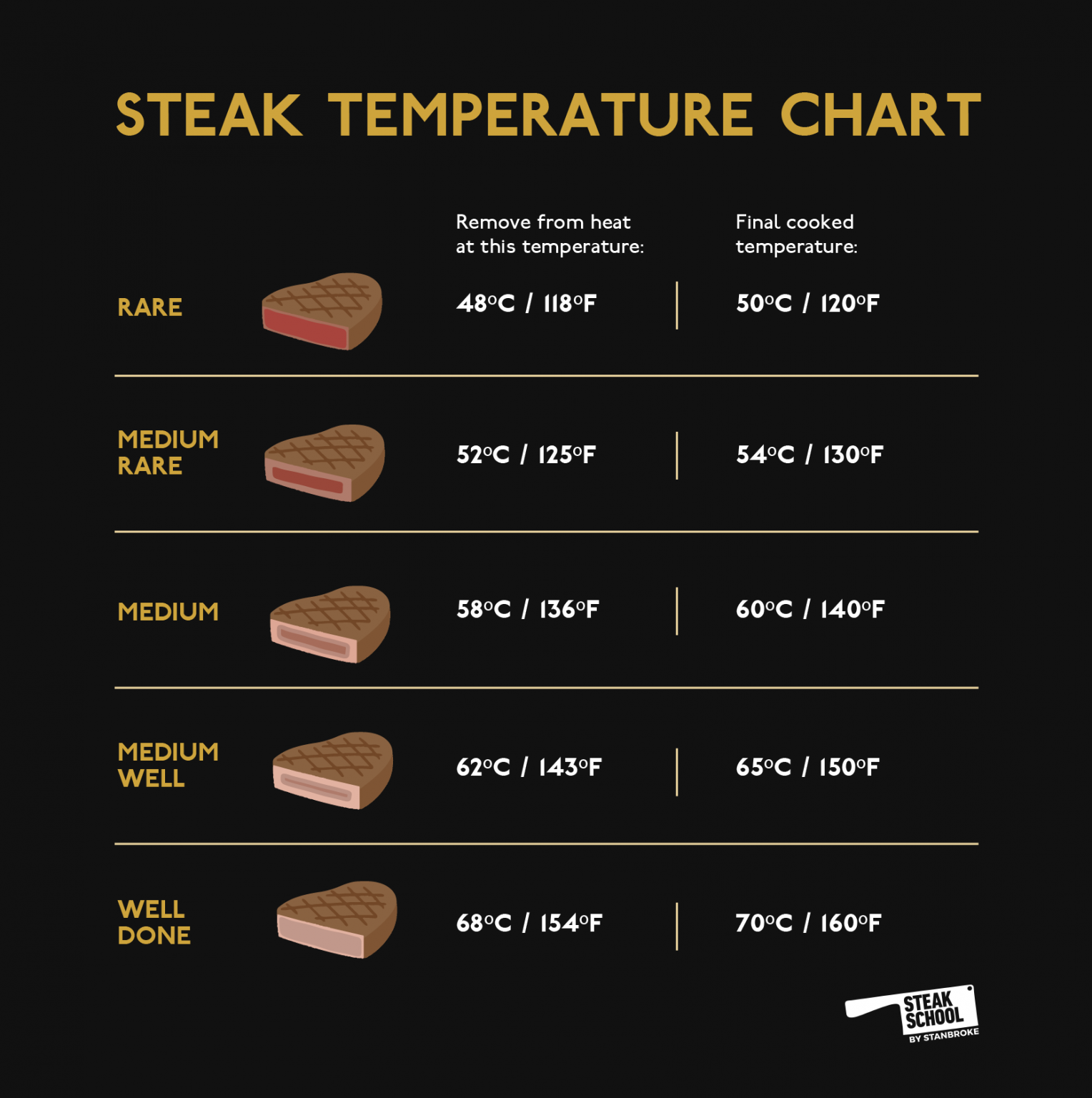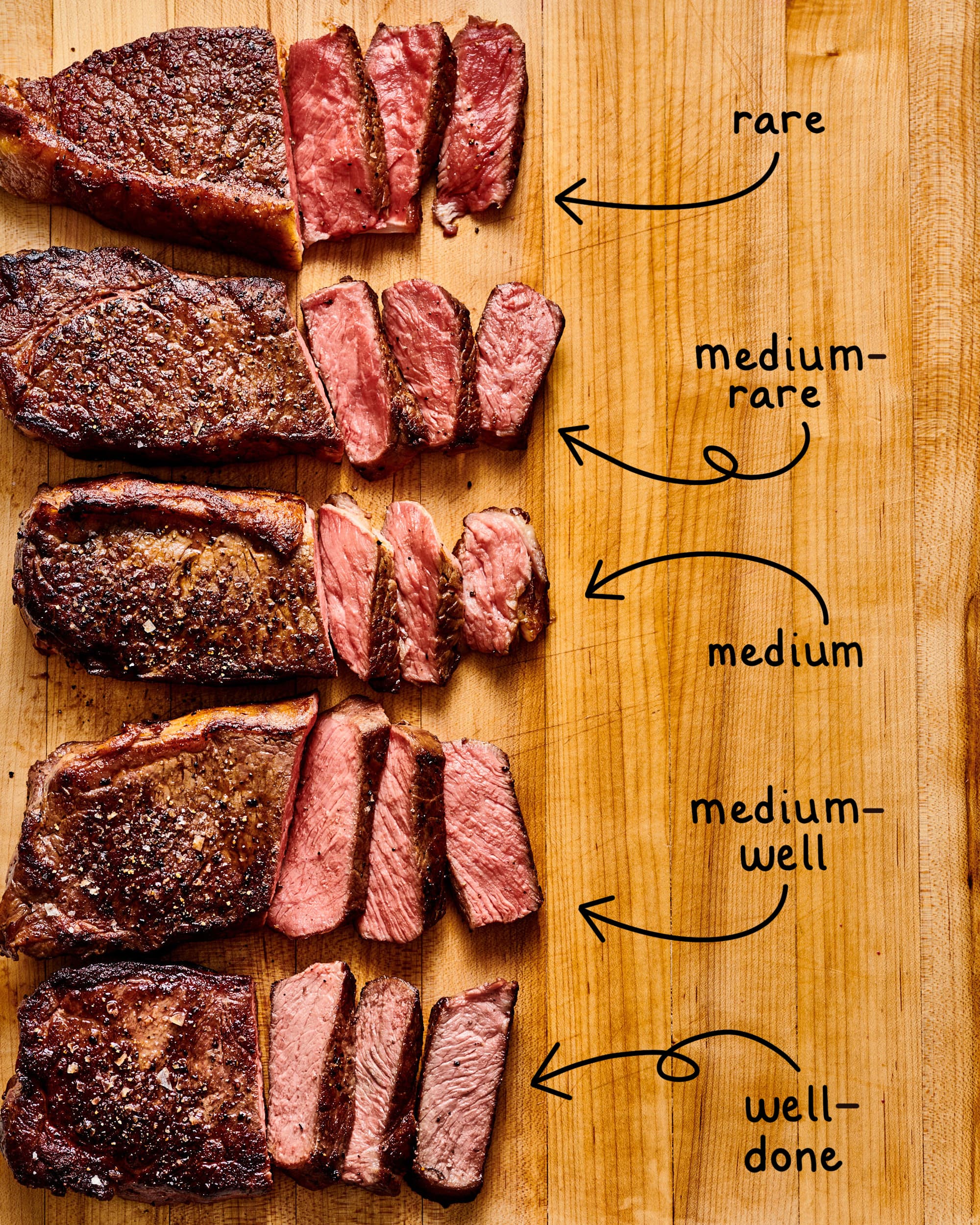Perfect Steak Doneness Guide: Temperatures & Tips
Ever wondered how to achieve steak perfection, that moment when the knife glides through the meat, and the flavor explodes on your palate? Understanding steak doneness levels is the secret to unlocking this culinary artistry, transforming a simple cut of beef into a gourmet experience.
The journey to a perfectly cooked steak is a dance between heat and time, a delicate balance that dictates the final texture and taste. The desired level of doneness from the barely-seared blue rare to the thoroughly-cooked well done is determined by internal temperature. Reaching this equilibrium consistently requires a reliable method to measure the internal temperature and control the cooking process.
Whether you're a seasoned grill master or a novice in the kitchen, the following guide is your companion. This comprehensive approach will demystify the art of cooking steak, providing the knowledge and tools needed to consistently prepare a steak that is precisely to your liking.
- Explore Alice Rosenblum On Onlyfans Photos Videos More
- Alice Rosenblum Unveiling Leaks Onlyfans More Latest Info
Here's a table detailing the key aspects of steak doneness:
| Doneness Level | Internal Temperature (°F) | Appearance | Characteristics | Recommended Cuts | Notes |
|---|---|---|---|---|---|
| Blue Rare | 115-120°F | Very red center, barely seared exterior | Almost raw, very tender, cool center | Filet Mignon, Ribeye | Not recommended for those with health concerns; the least cooked of all steaks. |
| Rare | 125-130°F | Red center, seared exterior | Soft, juicy, and full of flavor | Ribeye, Strip Steak, Sirloin | A classic choice; showcases the natural flavor of the meat. |
| Medium Rare | 130-140°F | Warm red center, slightly pink | Tender and succulent, still juicy | Ribeye, New York Strip, Porterhouse | One of the most popular doneness levels, offering a balance of flavor and texture. |
| Medium | 140-150°F | Warm pink center | Tender, but with a bit more firmness, still juicy | Most steak cuts | A safe choice, offering a balance of doneness and flavor. |
| Medium Well | 150-155°F | Slightly pink center | Less tender than medium, but still has some moisture | Thicker cuts, such as Ribeye and Sirloin | Can be prone to drying out if cooked too long. |
| Well Done | 160°F + | No pink, grey throughout | Firm, dry, and less flavorful | Not generally recommended | Omaha Steaks does not recommend this doneness level, because it can be tough. |
Reference: Omaha Steaks Steak Doneness Guide
The temperature is your compass in this culinary adventure. A meat thermometer is essential; it will provide you with the precise information to guide you to the final result. The thermometer should be placed in the thickest part of the steak, avoiding any bones. After you have placed the thermometer in the center of the steak, wait for the internal temperature of the steak to reach your preferred doneness level.
Consider that the steak will continue to cook even after it's removed from the heat source. This is called "carryover cooking". You should plan for that by removing the steak a few degrees before it reaches its desired internal temperature. This is a crucial aspect of the cooking process, and failing to consider carryover cooking can lead to an overcooked steak. The longer the steak cooks, the more the internal temperature will rise.
The recommended cut for a medium well doneness level can be thicker cuts of steak, such as Ribeye and Sirloin. At this point the steak retains a small amount of pinkness, but it has less moisture than lower temperature levels. If you are looking for a steak that is more on the tender side, this may not be the doneness level for you.
The process of determining doneness is not limited to internal temperature; visual cues are important too. The exterior appearance provides indications. When you cook a steak at 450F, it only takes 8 to 9 minutes per side. It is important to sear it to create a brown exterior. The center will gradually change color as it cooks. A blue rare steak is going to be almost raw.
For a medium rare steak, you want the center to be warm and a little pink. A medium steak will have a warm pink center and it will be cooked. The well done steak will be completely brown throughout, and will be visually smaller. Well done is also very firm and dry and is often critiqued for being tough and dry due to the lack of moisture.
Grilling a steak may seem straightforward, but there is an art to it, especially when it comes to doneness. The beauty of experimenting with steak temperatures is that each one leads to a different end result in terms of flavor and texture. Some people enjoy steaks that are more well done, while others enjoy steaks that are pinker and juicier. The USDA recommends cooking steaks and roasts to 145F (medium) and resting them for at least 3 minutes. Keep in mind, for food safety, ground beef should be cooked to a minimum of 160F (well done).
Resting is crucial. Once the steak is removed from the heat, allow it to rest for about five to ten minutes before slicing. This allows the juices to redistribute throughout the meat, resulting in a more tender and flavorful steak. Before slicing, be sure the steak has had time to rest. A good cut can be ruined if the steak is sliced too early.
In order to cook a steak to your desired doneness, you will need a meat thermometer. The internal temperature for each level of doneness is different. Don't worry, it is easy to do! You'll be able to prepare a perfect steak every time. With this guide and chart, you can ensure you have the best results.
The blue rare steak is ready when it reaches an internal temperature of no more than 115F to 120F (46C to 49C). A blue rare steak is not far removed from raw meat. For this reason, this steak temperature guide will answer all the questions raised in your mind about the steak and its cooking, to help you cook the steak at the perfect temperature and get the doneness according to your preferences.
If you want to cook your steak to a medium well doneness level, be sure to stop cooking it when the temperature hits 155F. Be mindful of overcooking the meat, or else it can become chewy and dry. This level of doneness is often critiqued for being tough and dry due to the lack of moisture.
Consider utilizing a braised cut like beef short ribs or go for a super low and slow cut like smoked brisket, as a substitute for steak. This will add a level of dimension to your dinner. Remember, the temperatures for each type of steak cut is the best way to cook your steak to perfection from rare to well done. Cooking it longer can result in dry or tough steak.
With the knowledge of the different doneness levels and the proper use of a meat thermometer, you are well on your way to producing steak perfection. No more guesswork, no more disappointment. Whether you prefer your steak rare, medium, or well done, you are now empowered to cook a steak that is exactly to your liking. The temperatures and cooking times for searing the perfect steak is in your hands.



Detail Author:
- Name : Axel Abernathy
- Username : purdy.eleanore
- Email : gregoria53@gmail.com
- Birthdate : 1996-04-19
- Address : 8295 Brody Drive Port Isaiastown, MS 84629
- Phone : +1-916-968-8431
- Company : Welch-Bins
- Job : Travel Agent
- Bio : Libero molestiae esse earum nulla aut a et. Vitae dolorem facilis ducimus ut voluptatum quis consequatur. Est delectus autem inventore eum praesentium ea.
Socials
tiktok:
- url : https://tiktok.com/@karine_xx
- username : karine_xx
- bio : Quisquam odio quo esse reiciendis corrupti nemo id.
- followers : 2976
- following : 2947
facebook:
- url : https://facebook.com/karine6630
- username : karine6630
- bio : Ut aliquid minus ea labore quo.
- followers : 3129
- following : 1408
instagram:
- url : https://instagram.com/karine2513
- username : karine2513
- bio : Error nobis ipsa sint ut cumque totam. Distinctio molestiae cumque aut et. Et aut ex et.
- followers : 1579
- following : 2143
twitter:
- url : https://twitter.com/karinecarter
- username : karinecarter
- bio : Sed temporibus voluptas quo ipsum rerum et. Est consectetur quisquam non numquam quidem.
- followers : 2654
- following : 2609